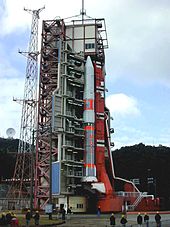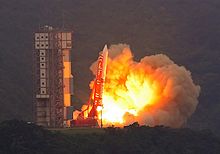Mu (rocket)

Mu or M or Myū (after the respective transcription of the 12th Greek letter μ ) denotes a series of Japanese launch vehicles that were used from 1966 to 2006. All rockets in the series used solid rocket engines and were launched from the Uchinoura Space Center . They continued the Japanese line of development of solid fuel rockets by ISAS for scientific payloads. The forerunners were also designated with Greek letters.
Former Japanese Mu series launch vehicles
In 1966, the Mu-1, the first rocket in the series, was tested on a suborbital flight. The following rocket types up to Mu-V are summarized as Mu-3: In 1969 there was a suborbital launch of Mu-3D. In 1971 (after a failure in 1970) the Japanese satellite Tansei 1 was launched on February 16 with the four-stage Mu-4S , further launches followed until 1972. With the three-stage successor Mu-3C, three satellites were successfully launched from 1974 to 1979. The next generation was the Mu-3H, this rocket was in service from 1977 to 1978. Its successor, the Mu-3S, was in use from 1980 to 1984. Mu-3S2 followed in the years from 1985 to 1995.
Variants of the launch vehicle MU
| Mu-4S | Mu-3C | Mu-3H | Mu-3S | Mu-3SII | Mu-V | |
|---|---|---|---|---|---|---|
| Start period | 1970-1972 | 1974-1979 | 1977-1988 | 1980-1984 | 1985-1993 | 1997-2006 |
| Payload LEO |
180 kg | 195 kg | 270 kg | 290 kg | 770 kg | 1900 kg |
| Takeoff mass | 43.5 t | 41.6 t | 48.7 t | 49.5 t | 61.7 t | 140 t |
| construction | 4 level + 8 boosters | 3 levels + 8 boosters | 4 levels + 8 boosters | 3 levels + 8 boosters | 4 levels + 2 boosters | 3 levels or 4 levels |
| Starts | 4th | 4th | 3 | 4th | 8th | 7th |
| failure | 1 false start | 1 false start | 1 false start | 1 false start | ||
| Special | Limited controllability | Enlarged diameter, 2nd and 3rd stage new |
supplemented by 4th level and extension of 1st level |
Minor changes | New boosters, 4th level |
Rocket completely new, 4th stage optional |
Swell:
Mu-V
Mu-V was used from 1997 to 2006. Of the seven - six of them successfully - launched, four were with the three-stage Mu-V (one false start) and three with the four-stage Mu-V KM (payloads: HALCA (MUSES-B) 1997, Nozomi (Planet-B) 1998 and Hayabusa (MUSES-C) 2003).
The maximum payload was 1,800 kg in a 30 ° orbit at an altitude of 200 km or 1,300 kg in a polar orbit at an altitude of 200 km for Mu-V and 1,800 kg in a 30 ° orbit at an altitude of 400 km for Mu-V KM . The total mass of the Mu-V was 137,500 kg, that of the Mu-V KM 139,000 kg. An improved Mu-V rocket has been used since 2003, which differs from the original model by a new second stage.
On July 26, 2006, JAXA announced that they no longer wanted to use the Mu-V after the SOLAR-B launch. Instead, a new type of launch vehicle based on a mixture of the technologies of the Mu-V and the H-IIA should be developed. The first launch of the new Epsilon launcher was announced for 2010 and took place in September 2013.
Potential ICBM
Due to the solid rocket engine and high throwing weight, this system was suitable as an ICBM . Only the payload and the steering system would have had to be exchanged. The performance of the Mu-V was comparable to that of the most modern LGM-118 Peacekeeper intercontinental ballistic missile.
Toshiyuki Shikata, Government Advisor and General a. D. declared in 2011 that one of the reasons for the Hayabusa mission was to demonstrate by re-entering and landing the capsule back on earth that “Japan's ability to build ICBMs is credible”.
See also
Web links
- Mu missiles at JAXA (English)
- Page about the Mu-V at JAXA. (English)
Individual evidence
- ↑ Bernd Leitenberger: Japanese launchers L and M series. 2012, accessed November 11, 2012 .
- ↑ Launch Result of Epsilon-1 with SPRINT-A aboard. JAXA, accessed October 7, 2013 .
- ^ William E. Rapp: Paths Diverging? The Next Decade in the US-Japan Security Alliance . In: Strategic Studies Institute, US Army War College . January 2004, p. 82. Retrieved October 29, 2012. “119. Japan has the weapons grade plutonium, technology for weaponization, and delivery means in the MV-5 rocket, indigenous, solid fueled, 1800kg payload capacity, to go nuclear very rapidly should it choose. This dramatic step, however, would require a complete loss of faith in the American nuclear umbrella "
- ^ In Japan, Provocative Case for Staying Nuclear. Retrieved February 3, 2015 .



